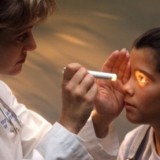Pediatric Retinoblastoma Relapse
Pediatric retinoblastoma is the most common type of eye tumor that develops in children. Pediatric retinoblastoma has a high rate of curability, with about 95 percent of patients being cured of the disease and roughly 90 percent retaining vision in at least one eye. However, the genetic nature of the disease increases the probability of relapse and the formation of secondary tumors.
Retinoblastoma Relapse Cause
In hereditary retinoblastoma, patients often have the genetic mutation that causes retinoblastoma in the RB1 gene in all cells of the body. Besides the egg and sperm cells, all cells of the body ordinarily have two RB1 genes. In patients with the genetic mutation, any change in the remaining RB1 gene in any body cell can cause a retinoblastoma tumor to develop in that cell. Patients with non-hereditary retinoblastoma are not as susceptible to relapse.
Hereditary Retinoblastoma
In only about 10 to 20 percent of cases of hereditary retinoblastoma does a child inherit the mutated RB1 gene from a parent with the same genetic mutation. In most cases, the RB1 mutation is a result of an abnormality in an RB1 gene in the father’s sperm or the mother’s egg. While the child will be the first in the family to have retinoblastoma, it is considered hereditary retinoblastoma. In rare cases, parents may carry the RB1 mutation in some body cells but not others, allowing the mutation to be passed on but not causing tumors to form in the parent. Patients that have hereditary retinoblastoma have a 50 percent chance of passing the disease on to children.
Additional Tumor Development
In addition to the increased likelihood of retinoblastoma relapse, patients that have hereditary retinoblastoma are also much more likely to develop additional tumors. Tumors may develop anywhere in the body, most commonly in the bones or muscles. The risk of developing additional tumors is increased by the use of radiation therapy, so this type of treatment should be avoided in patients with hereditary retinoblastoma.
Preventing Retinoblastoma Relapse
Patients that have undergone successful treatment for hereditary pediatric retinoblastoma should be frequently screened for cancers of all kinds. Since pediatric retinoblastoma typically affects children under the age of five, this means lifetime monitoring. Patients should always make physicians aware of the retinoblastoma history and the increased risk for cancer development.
Healthy Lifestyle
A healthy lifestyle can also help to prevent pediatric retinoblastoma relapse. Behaviors such as smoking, drinking alcohol, and eating an unbalanced diet may greatly increase the chances of tumor development I those that have the RB1 mutation. Patients should also be alert for any abnormalities or pains that may be an indication of retinoblastoma relapse or additional tumor development.
Sources:
http://www.dana-farber.org/Health-Library/Childhood-Retinoblastoma.aspx
http://www.hopkinsmedicine.org/kimmel_cancer_center/centers/pediatric_oncology/cancer_types/retinoblastoma.htm
http://www.mskcc.org/pediatrics/childhood/retinoblastoma/diagnosis-treatment-msk

















